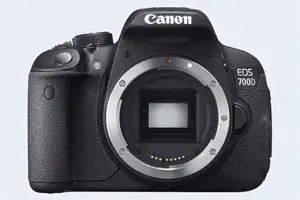Nikon D3300 vs Canon 700D
The Nikon D3300 and the Canon EOS 700D (labelled Canon T5i in some countries) are two digital cameras that were officially introduced, respectively, in January 2014 and March 2013. Both are DSLR (Digital Single Lens Reflex) cameras that are equipped with an APS-C sensor. The Nikon has a resolution of 24 megapixels, whereas the Canon provides 17.9 MP.
Below is an overview of the main specs of the two cameras as a starting point for the comparison.

Check D3300 offers at
ebay.com

Check 700D offers at
ebay.com
Going beyond this snapshot of core features and characteristics, what are the differences between the Nikon D3300 and the Canon EOS 700D? Which one should you buy? Read on to find out how these two cameras compare with respect to their body size, their imaging sensors, their shooting features, their input-output connections, and their reception by expert reviewers.
Body comparison
The side-by-side display below illustrates the physical size and weight of the Nikon D3300 and the Canon 700D. The two cameras are presented according to their relative size. Three consecutive perspectives from the front, the top, and the back are available. All width, height and depth measures are rounded to the nearest millimeter.
The D3300 can be obtained in three different colors (black, grey, red), while the 700D is only available in black.
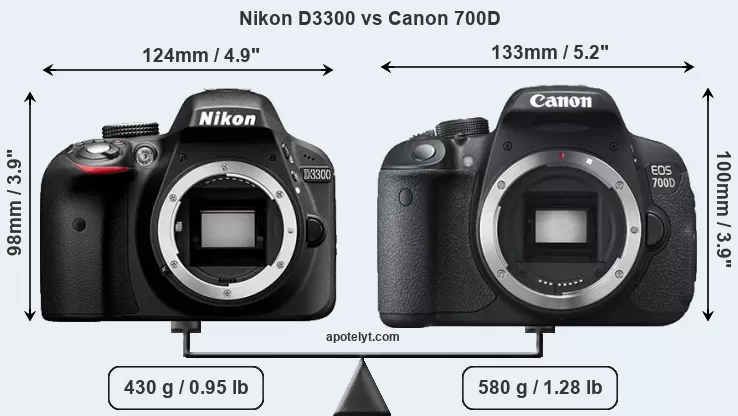
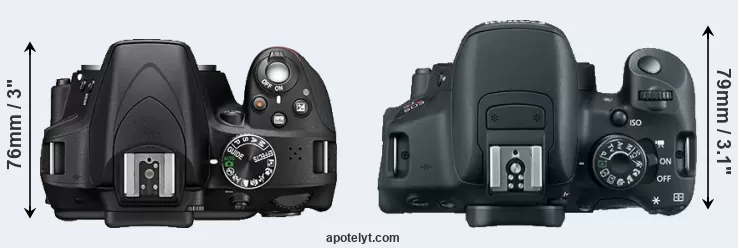
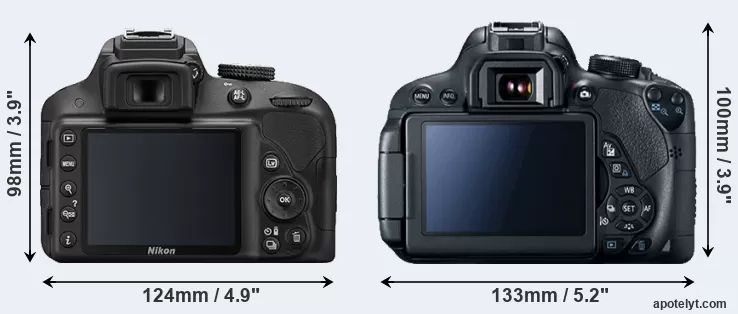
If the front view area (width x height) of the cameras is taken as an aggregate measure of their size, the Canon 700D is notably larger (9 percent) than the Nikon D3300. Moreover, the 700D is substantially heavier (35 percent) than the D3300. In this context, it is worth noting that neither the D3300 nor the 700D are weather-sealed.
The above size and weight comparisons are to some extent incomplete since they do not consider the interchangeable lenses that both of these cameras require. Yet, since both cameras are based around an APS-C sensor, their respective lenses will tend to have similar dimensions and heft. You can compare the optics available for the two cameras in the Nikon Lens Catalog (D3300) and the Canon EF Lens Catalog (700D).
Concerning battery life, the D3300 gets 700 shots out of its Nikon EN-EL14a battery, while the 700D can take 440 images on a single charge of its Canon LP-E8 power pack.
The following table provides a synthesis of the main physical specifications of the two cameras and other similar ones. If you would like to visualize and compare a different camera combination, you can navigate to the CAM-parator app and make your selection from a broad list of cameras there.

| # | Camera Model |
Camera Width |
Camera Height |
Camera Depth |
Camera Weight |
Battery Life |
Weather Sealing |
Camera Launch |
Launch Price (USD) |
Street Price |
|
|---|---|---|---|---|---|---|---|---|---|---|---|
| 1. | Nikon D3300 | 124 mm | 98 mm | 76 mm | 430 g | 700 | n | Jan 2014 | 499 | ebay.com | |
| 2. | Canon 700D | 133 mm | 100 mm | 79 mm | 580 g | 440 | n | Mar 2013 | 649 | ebay.com | |
| 3. | Canon 750D | 132 mm | 101 mm | 78 mm | 555 g | 440 | n | Feb 2015 | 749 | ebay.com | |
| 4. | Canon 1200D | 130 mm | 100 mm | 78 mm | 480 g | 500 | n | Feb 2014 | 449 | ebay.com | |
| 5. | Canon 100D | 117 mm | 91 mm | 69 mm | 407 g | 380 | n | Mar 2013 | 549 | ebay.com | |
| 6. | Canon 650D | 133 mm | 100 mm | 79 mm | 575 g | 440 | n | Jun 2012 | 849 | ebay.com | |
| 7. | Canon 600D | 133 mm | 100 mm | 80 mm | 570 g | 440 | n | Feb 2011 | 599 | ebay.com | |
| 8. | Nikon D3500 | 124 mm | 97 mm | 70 mm | 415 g | 1550 | n | Aug 2018 | 429 | ebay.com | |
| 9. | Nikon D5600 | 124 mm | 97 mm | 70 mm | 465 g | 970 | n | Nov 2016 | 699 | ebay.com | |
| 10. | Nikon D3400 | 124 mm | 98 mm | 76 mm | 445 g | 1200 | n | Aug 2016 | 499 | ebay.com | |
| 11. | Nikon D5500 | 124 mm | 97 mm | 70 mm | 470 g | 820 | n | Jan 2015 | 899 | ebay.com | |
| 12. | Nikon D7100 | 136 mm | 107 mm | 76 mm | 765 g | 950 | Y | Feb 2013 | 1,199 | ebay.com | |
| 13. | Nikon D5300 | 125 mm | 98 mm | 76 mm | 480 g | 600 | n | Oct 2013 | 799 | ebay.com | |
| 14. | Nikon D3200 | 125 mm | 96 mm | 77 mm | 505 g | 540 | n | Apr 2012 | 599 | ebay.com | |
| 15. | Sony A5000 | 110 mm | 63 mm | 36 mm | 269 g | 420 | n | Jan 2014 | 449 | ebay.com | |
| 16. | Sony A5100 | 110 mm | 63 mm | 36 mm | 283 g | 400 | n | Aug 2014 | 549 | ebay.com | |
| 17. | Sony A6000 | 120 mm | 67 mm | 45 mm | 344 g | 360 | n | Feb 2014 | 599 | ebay.com | |
| Note: Measurements and pricing do not include easily detachable parts, such as add-on or interchangeable lenses or optional viewfinders. | |||||||||||
Any camera decision will obviously take relative prices into account. The manufacturer’s suggested retail prices give an idea on the placement of the camera in the maker’s lineup and the broader market. The D3300 was launched at a somewhat lower price (by 23 percent) than the 700D, which makes it more attractive for photographers on a tight budget. Usually, retail prices stay at first close to the launch price, but after several months, discounts become available. Later in the product cycle and, in particular, when the replacement model is about to appear, further discounting and stock clearance sales often push the camera price considerably down. Then, after the new model is out, very good deals can frequently be found on the pre-owned market.
Sensor comparison
The imaging sensor is at the core of digital cameras and its size is one of the main determining factors of image quality. A large sensor will generally have larger individual pixels that offer better low-light sensitivity, provide wider dynamic range, and have richer color-depth than smaller pixels in a sensor of the same technological generation. Further, a large sensor camera will give the photographer additional creative options when using shallow depth-of-field to isolate a subject from its background. On the downside, larger sensors tend to be associated with larger, more expensive camera bodies and lenses.
Both cameras under consideration feature an APS-C sensor, but their sensors differ slightly in size. The sensor area in the 700D is 10 percent smaller. As a result of these sensor size differences, the cameras have format factors, respectively, of 1.5 (D3300) and 1.6. Both cameras have a native aspect ratio (sensor width to sensor height) of 3:2.
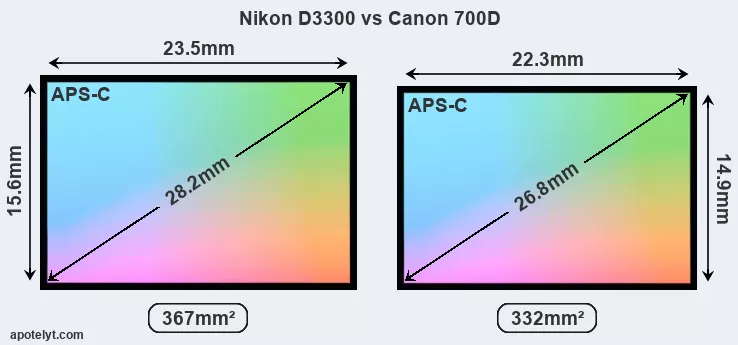
With 24MP, the D3300 offers a higher resolution than the 700D (17.9MP), but the D3300 has smaller individual pixels (pixel pitch of 3.91μm versus 4.31μm for the 700D). However, the D3300 is a somewhat more recent model (by 9 months) than the 700D, and its sensor might have benefitted from technological advances during this time that enhance the light gathering capacity of its pixels. Coming back to sensor resolution, it should be mentioned that the D3300 has no anti-alias filter installed, so that it can capture all the detail its sensor resolves.
The resolution advantage of the Nikon D3300 implies greater flexibility for cropping images or the possibility to print larger pictures. The maximum print size of the D3300 for good quality output (200 dots per inch) amounts to 30 x 20 inches or 76.2 x 50.8 cm, for very good quality (250 dpi) 24 x 16 inches or 61 x 40.6 cm, and for excellent quality (300 dpi) 20 x 13.3 inches or 50.8 x 33.9 cm. The corresponding values for the Canon 700D are 25.9 x 17.3 inches or 65.8 x 43.9 cm for good quality, 20.7 x 13.8 inches or 52.7 x 35.1 cm for very good quality, and 17.3 x 11.5 inches or 43.9 x 29.3 cm for excellent quality prints.
The 700D has on-sensor phase detect pixels, which results in fast and reliable autofocus acquisition even during live view operation.
The Nikon D3300 has a native sensitivity range from ISO 100 to ISO 12800, which can be extended to ISO 100-25600. The Canon EOS 700D offers exactly the same ISO settings.
Technology-wise, both cameras are equipped with CMOS (Complementary Metal–Oxide–Semiconductor) sensors. Both cameras use a Bayer filter for capturing RGB colors on a square grid of photosensors. This arrangement is found in most digital cameras.
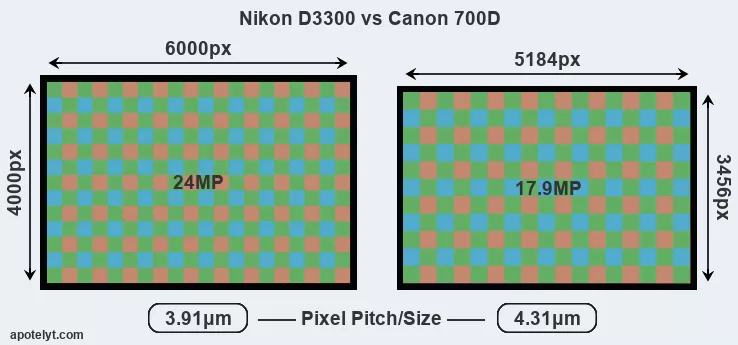
Consistent information on actual sensor performance is available from DXO Mark for many cameras. This service assesses and scores the color depth ("DXO Portrait"), dynamic range ("DXO Landscape"), and low-light sensitivity ("DXO Sports") of camera sensors, and also publishes an overall camera score. Of the two cameras under review, the D3300 provides substantially higher image quality than the 700D, with an overall score that is 21 points higher. This advantage is based on 2.6 bits higher color depth, 1.6 EV in additional dynamic range, and 1 stops in additional low light sensitivity. The adjacent table reports on the physical sensor characteristics and the outcomes of the DXO sensor quality tests for a sample of comparator-cameras.

| # | Camera Model |
Sensor Class |
Resolution (MP) |
Horiz. Pixels |
Vert. Pixels |
Video Format |
DXO Portrait |
DXO Landscape |
DXO Sports |
DXO Overall |
|
|---|---|---|---|---|---|---|---|---|---|---|---|
| 1. | Nikon D3300 | APS-C | 24.0 | 6000 | 4000 | 1080/60p | 24.3 | 12.8 | 1385 | 82 | |
| 2. | Canon 700D | APS-C | 17.9 | 5184 | 3456 | 1080/30p | 21.7 | 11.2 | 681 | 61 | |
| 3. | Canon 750D | APS-C | 24.0 | 6000 | 4000 | 1080/30p | 22.7 | 12.0 | 919 | 71 | |
| 4. | Canon 1200D | APS-C | 17.9 | 5184 | 3456 | 1080/30p | 21.9 | 11.3 | 724 | 63 | |
| 5. | Canon 100D | APS-C | 17.9 | 5184 | 3456 | 1080/30p | 21.8 | 11.3 | 843 | 63 | |
| 6. | Canon 650D | APS-C | 17.9 | 5184 | 3456 | 1080/30p | 21.7 | 11.2 | 722 | 62 | |
| 7. | Canon 600D | APS-C | 17.9 | 5184 | 3456 | 1080/30p | 22.1 | 11.5 | 793 | 65 | |
| 8. | Nikon D3500 | APS-C | 24.0 | 6000 | 4000 | 1080/60p | 24.0 | 13.4 | 1851 | 83 | |
| 9. | Nikon D5600 | APS-C | 24.0 | 6000 | 4000 | 1080/60p | 24.1 | 14.0 | 1306 | 84 | |
| 10. | Nikon D3400 | APS-C | 24.0 | 6000 | 4000 | 1080/60p | 24.8 | 13.9 | 1192 | 86 | |
| 11. | Nikon D5500 | APS-C | 24.0 | 6000 | 4000 | 1080/60p | 24.1 | 14.0 | 1438 | 84 | |
| 12. | Nikon D7100 | APS-C | 24.0 | 6000 | 4000 | 1080/60p | 24.2 | 13.7 | 1256 | 83 | |
| 13. | Nikon D5300 | APS-C | 24.0 | 6000 | 4000 | 1080/60p | 24.0 | 13.9 | 1338 | 83 | |
| 14. | Nikon D3200 | APS-C | 24.1 | 6016 | 4000 | 1080/30p | 24.1 | 13.2 | 1131 | 81 | |
| 15. | Sony A5000 | APS-C | 19.8 | 5456 | 3632 | 1080/60i | 23.8 | 13.0 | 1089 | 79 | |
| 16. | Sony A5100 | APS-C | 24.0 | 6000 | 4000 | 1080/60p | 23.8 | 12.7 | 1347 | 80 | |
| 17. | Sony A6000 | APS-C | 24.0 | 6000 | 4000 | 1080/60p | 24.1 | 13.1 | 1347 | 82 | |
| Note: DXO values in italics represent estimates based on sensor size and age. | |||||||||||
Many modern cameras cannot only take still pictures, but also record videos. Both cameras under consideration are equipped with sensors that have a sufficiently high read-out speed for moving images, but the D3300 provides a higher frame rate than the 700D. It can shoot video footage at 1080/60p, while the Canon is limited to 1080/30p.
Feature comparison
Apart from body and sensor, cameras can and do differ across a variety of features. The D3300 and the 700D are similar in the sense that both have an optical viewfinder. The latter is useful for getting a clear image for framing even in brightly lit environments. The viewfinders of both cameras offer the same field of view (95%), but the viewfinder of the D3300 has a higher magnification than the one of the 700D (0.57x vs 0.53x), so that the size of the image transmitted appears closer to the size seen with the naked human eye. The table below summarizes some of the other core capabilities of the Nikon D3300 and Canon 700D in connection with corresponding information for a sample of similar cameras.

| # | Camera Model |
Viewfinder (Type or 000 dots) |
Control Panel (yes/no) |
LCD Specifications (inch/000 dots) |
LCD Attach- ment |
Touch Screen (yes/no) |
Max Shutter Speed * |
Max Shutter Flaps * |
Built-in Flash (yes/no) |
Built-in Image Stab |
|
|---|---|---|---|---|---|---|---|---|---|---|---|
| 1. | Nikon D3300 | optical | n | 3.0 / 921 | fixed | n | 1/4000s | 5.0/s | Y | n | |
| 2. | Canon 700D | optical | n | 3.0 / 1040 | swivel | Y | 1/4000s | 5.0/s | Y | n | |
| 3. | Canon 750D | optical | n | 3.0 / 1040 | swivel | Y | 1/4000s | 5.0/s | Y | n | |
| 4. | Canon 1200D | optical | n | 3.0 / 460 | fixed | n | 1/4000s | 3.0/s | Y | n | |
| 5. | Canon 100D | optical | n | 3.0 / 1040 | fixed | Y | 1/4000s | 4.9/s | Y | n | |
| 6. | Canon 650D | optical | n | 3.0 / 1040 | swivel | Y | 1/4000s | 5.0/s | Y | n | |
| 7. | Canon 600D | optical | n | 3.0 / 1040 | swivel | n | 1/4000s | 3.7/s | Y | n | |
| 8. | Nikon D3500 | optical | n | 3.0 / 921 | fixed | n | 1/4000s | 5.0/s | Y | n | |
| 9. | Nikon D5600 | optical | n | 3.2 / 1037 | swivel | Y | 1/4000s | 5.0/s | Y | n | |
| 10. | Nikon D3400 | optical | n | 3.0 / 921 | fixed | n | 1/4000s | 5.0/s | Y | n | |
| 11. | Nikon D5500 | optical | n | 3.2 / 1037 | swivel | Y | 1/4000s | 5.0/s | Y | n | |
| 12. | Nikon D7100 | optical | Y | 3.2 / 1229 | fixed | n | 1/8000s | 6.0/s | Y | n | |
| 13. | Nikon D5300 | optical | n | 3.2 / 1037 | swivel | n | 1/4000s | 5.0/s | Y | n | |
| 14. | Nikon D3200 | optical | n | 3.0 / 921 | fixed | n | 1/4000s | 4.0/s | Y | n | |
| 15. | Sony A5000 | none | n | 3.0 / 461 | tilting | n | 1/4000s | 3.5/s | Y | n | |
| 16. | Sony A5100 | none | n | 3.0 / 922 | tilting | Y | 1/4000s | 6.0/s | Y | n | |
| 17. | Sony A6000 | 1440 | n | 3.0 / 922 | tilting | n | 1/4000s | 11.0/s | Y | n | |
| Note: *) Information refers to the mechanical shutter, unless the camera only has an electronic one. | |||||||||||
One differentiating feature between the two cameras concerns the touch sensitivity of the rear screen. The 700D has a touchscreen, while the D3300 has a conventional panel. Touch control can be particularly helpful, for example, for setting the focus point.
The 700D has an articulated screen that can be turned to be front-facing. This characteristic will be appreciated by vloggers and photographers who are interested in taking selfies. In contrast, the D3300 does not have a selfie-screen.Concerning the storage of imaging data, both the D3300 and the 700D write their files to SDXC cards. Both cameras can use UHS-I cards, which provide for Ultra High Speed data transfer of up to 104 MB/s.
Connectivity comparison
For some imaging applications, the extent to which a camera can communicate with its environment can be an important aspect in the camera decision process. The table below provides an overview of the connectivity of the Nikon D3300 and Canon EOS 700D and, in particular, the interfaces the cameras (and selected comparators) provide for accessory control and data transfer.

| # | Camera Model |
Hotshoe Port |
Internal Mic / Speaker |
Microphone Port |
Headphone Port |
HDMI Port |
USB Port |
WiFi Support |
NFC Support |
Bluetooth Support |
|
|---|---|---|---|---|---|---|---|---|---|---|---|
| 1. | Nikon D3300 | Y | mono / mono | Y | - | mini | 2.0 | - | - | - | |
| 2. | Canon 700D | Y | stereo / mono | Y | - | mini | 2.0 | - | - | - | |
| 3. | Canon 750D | Y | stereo / mono | Y | - | mini | 2.0 | Y | Y | - | |
| 4. | Canon 1200D | Y | mono / mono | - | - | mini | 2.0 | - | - | - | |
| 5. | Canon 100D | Y | mono / mono | Y | - | mini | 2.0 | - | - | - | |
| 6. | Canon 650D | Y | stereo / mono | Y | - | mini | 2.0 | - | - | - | |
| 7. | Canon 600D | Y | mono / mono | Y | - | mini | 2.0 | - | - | - | |
| 8. | Nikon D3500 | Y | mono / mono | - | - | mini | 2.0 | - | - | Y | |
| 9. | Nikon D5600 | Y | stereo / mono | Y | - | mini | 2.0 | Y | Y | Y | |
| 10. | Nikon D3400 | Y | mono / mono | - | - | mini | 2.0 | - | - | Y | |
| 11. | Nikon D5500 | Y | stereo / mono | Y | - | mini | 2.0 | Y | - | - | |
| 12. | Nikon D7100 | Y | stereo / mono | Y | Y | mini | 2.0 | - | - | - | |
| 13. | Nikon D5300 | Y | stereo / mono | Y | - | mini | 2.0 | Y | - | - | |
| 14. | Nikon D3200 | Y | mono / mono | Y | - | mini | 2.0 | - | - | - | |
| 15. | Sony A5000 | - | stereo / mono | - | - | micro | 2.0 | Y | Y | - | |
| 16. | Sony A5100 | - | stereo / mono | - | - | micro | 2.0 | Y | Y | - | |
| 17. | Sony A6000 | Y | stereo / mono | - | - | micro | 2.0 | Y | Y | - |
Both the D3300 and the 700D have been discontinued, but can regularly be found used on ebay. The 700D was replaced by the Canon 750D, while the D3300 was followed by the Nikon D3400. Further information on the features and operation of the D3300 and 700D can be found, respectively, in the Nikon D3300 Manual (free pdf) or the online Canon 700D Manual.
Review summary
So how do things add up? Is there a clear favorite between the Nikon D3300 and the Canon 700D? Which camera is better? A synthesis of the relative strong points of each of the models is listed below.

Reasons to prefer the Nikon D3300:
- More detail: Offers more megapixels (24 vs 17.9MP) with a 16% higher linear resolution.
- Maximized detail: Lacks an anti-alias filter to exploit the sensor's full resolution potential.
- Better image quality: Scores substantially higher (21 points) in the DXO overall assessment.
- Richer colors: Generates images with noticeably better colors (2.6 bits more color depth).
- More dynamic range: Captures a larger spectrum of light and dark details (1.6 EV of extra DR).
- Better low-light sensitivity: Requires less light for good images (1 stops ISO advantage).
- Better video: Provides higher movie framerates (1080/60p versus 1080/30p).
- Larger viewfinder image: Features a viewfinder with a higher magnification (0.57x vs 0.53x).
- Less heavy: Is lighter (by 150g or 26 percent) and hence easier to carry around.
- Longer lasting: Can take more shots (700 versus 440) on a single battery charge.
- More affordable: Was introduced into a lower priced segment (23 percent cheaper at launch).
- More modern: Is somewhat more recent (announced 9 months after the 700D).

Advantages of the Canon EOS 700D:
- Better moiré control: Has an anti-alias filter to avoid artificial patterns to appear in images.
- Better live-view autofocus: Features on-sensor phase-detection for more confident autofocus.
- More detailed LCD: Has a higher resolution rear screen (1040k vs 921k dots).
- More flexible LCD: Has a swivel screen for odd-angle shots in portrait or landscape orientation.
- Fewer buttons to press: Has a touchscreen to facilitate handling and shooting adjustments.
- More selfie-friendly: Has an articulated screen that can be turned to be front-facing.
- More heavily discounted: Has been on the market for longer (launched in March 2013).
If the number of relative strengths (bullet points above) is taken as a guide, the D3300 is the clear winner of the match-up (12 : 7 points). However, the relevance of individual strengths will vary across photographers, so that you might want to apply your own weighing scheme to the summary points when reflecting and deciding on a new camera. A professional wedding photographer will view the differences between cameras in a way that diverges from the perspective of a travel photog, and a person interested in cityscapes has distinct needs from a macro shooter. Hence, the decision which camera is best and worth buying is often a very personal one.
How about other alternatives? Do the specifications of the Nikon D3300 and the Canon 700D place the cameras among the top in their class? Find out in the latest Best DSLR Camera listing whether the two cameras rank among the cream of the crop.
In any case, while the comparison of the spec-sheets of cameras can offer a general idea of their imaging potential, it remains incomplete and does no justice, for example, to the way the D3300 or the 700D perform in practice. User reviews that are available, for instance, at amazon can sometimes shed light on these issues, but such feedback is all too often partial, inconsistent, and inaccurate.
Expert reviews
This is where reviews by experts come in. The following table reports the overall ratings of the cameras as published by some of the major camera review sites (amateurphotographer [AP], cameralabs [CL], digitalcameraworld [DCW], dpreview [DPR], ephotozine [EPZ], photographyblog [PB]). As can be seen, the professional reviewers agree in many cases on the quality of different cameras, but sometimes their assessments diverge, reinforcing the earlier point that a camera decision is often a very personal choice.

| # | Camera Model |
AP score |
CL score |
DCW score |
DPR score |
EPZ score |
PB score |
Camera Launch |
Launch Price (USD) |
Street Price |
|
|---|---|---|---|---|---|---|---|---|---|---|---|
| 1. | Nikon D3300 | 3/5 | + | .. | 77/100 | 4.5/5 | 4.5/5 | Jan 2014 | 499 | ebay.com | |
| 2. | Canon 700D | .. | .. | .. | 76/100 | 4.5/5 | 4.5/5 | Mar 2013 | 649 | ebay.com | |
| 3. | Canon 750D | 5/5 | .. | .. | 75/100 | 4.5/5 | 4.5/5 | Feb 2015 | 749 | ebay.com | |
| 4. | Canon 1200D | 3/5 | + | .. | .. | 4/5 | 4.5/5 | Feb 2014 | 449 | ebay.com | |
| 5. | Canon 100D | 4/5 | + | .. | 78/100 | 4/5 | 4/5 | Mar 2013 | 549 | ebay.com | |
| 6. | Canon 650D | 4/5 | + + | .. | 77/100 | 4.5/5 | 4.5/5 | Jun 2012 | 849 | ebay.com | |
| 7. | Canon 600D | 3/5 | o | .. | 77/100 | 4.5/5 | 4.5/5 | Feb 2011 | 599 | ebay.com | |
| 8. | Nikon D3500 | 4/5 | .. | 4/5 | 75/100 | 4/5 | 4.5/5 | Aug 2018 | 429 | ebay.com | |
| 9. | Nikon D5600 | 4/5 | .. | 4/5 | 79/100 | 4.5/5 | 4/5 | Nov 2016 | 699 | ebay.com | |
| 10. | Nikon D3400 | 4/5 | + | 4/5 | 76/100 | 4/5 | 4.5/5 | Aug 2016 | 499 | ebay.com | |
| 11. | Nikon D5500 | 5/5 | + | .. | 79/100 | 4.5/5 | 4.5/5 | Jan 2015 | 899 | ebay.com | |
| 12. | Nikon D7100 | 5/5 | + + | .. | 85/100 | 4.5/5 | 4.5/5 | Feb 2013 | 1,199 | ebay.com | |
| 13. | Nikon D5300 | 4/5 | + + | .. | 79/100 | 4.5/5 | 4.5/5 | Oct 2013 | 799 | ebay.com | |
| 14. | Nikon D3200 | 5/5 | + + | .. | 73/100 | 4.5/5 | 4.5/5 | Apr 2012 | 599 | ebay.com | |
| 15. | Sony A5000 | 3/5 | + | .. | .. | 4.5/5 | 4.5/5 | Jan 2014 | 449 | ebay.com | |
| 16. | Sony A5100 | 4.5/5 | + | .. | .. | 4.5/5 | 5/5 | Aug 2014 | 549 | ebay.com | |
| 17. | Sony A6000 | 5/5 | + | 4.5/5 | 80/100 | 4.5/5 | 5/5 | Feb 2014 | 599 | ebay.com | |
| Note: (+ +) highly recommended; (+) recommended; (o) reviewed; (..) not available. | |||||||||||
Care should be taken when interpreting the review scores above, though. The assessments were made in relation to similar cameras of the same technological generation. A score, therefore, has to be seen in close connection to the price and market introduction time of the camera, and rating-comparisons among cameras that span long time periods or concern very differently equipped models make little sense. Also, kindly note that some of the listed sites have over time developped their review approaches and their reporting style.

Check D3300 offers at
ebay.com

Check 700D offers at
ebay.com
Other camera comparisons
Did this review help to inform your camera decision process? In case you would like to check on the differences and similarities of other camera models, just use the search menu below. As an alternative, you can also directly jump to any one of the listed comparisons that were previously generated by the CAM-parator tool.
- Canon 700D vs Contax N Digital
- Canon 700D vs Fujifilm X-H2
- Canon 700D vs Nikon D50
- Canon 700D vs Nikon D750
- Canon 700D vs Panasonic G10
- Canon 700D vs Panasonic L1
- Canon 90D vs Nikon D3300
- Canon G12 vs Nikon D3300
- Canon T3 vs Nikon D3300
- Fujifilm X-T30 II vs Nikon D3300
- Leica TL vs Nikon D3300
- Nikon D3300 vs Sony A7R IV
Specifications: Nikon D3300 vs Canon 700D
Below is a side-by-side comparison of the specs of the two cameras to facilitate a quick review of their differences and common features.
| Camera Model | Nikon D3300 | Canon 700D |
|---|---|---|
| Camera Type | Digital single lens reflex | Digital single lens reflex |
| Camera Lens | Nikon F mount lenses | Canon EF mount lenses |
| Launch Date | January 2014 | March 2013 |
| Launch Price | USD 499 | USD 649 |
| Sensor Specs | Nikon D3300 | Canon 700D |
| Sensor Technology | CMOS | CMOS |
| Sensor Format | APS-C Sensor | APS-C Sensor |
| Sensor Size | 23.5 x 15.6 mm | 22.3 x 14.9 mm |
| Sensor Area | 366.6 mm2 | 332.27 mm2 |
| Sensor Diagonal | 28.2 mm | 26.8 mm |
| Crop Factor | 1.5x | 1.6x |
| Sensor Resolution | 24 Megapixels | 17.9 Megapixels |
| Image Resolution | 6000 x 4000 pixels | 5184 x 3456 pixels |
| Pixel Pitch | 3.91 μm | 4.31 μm |
| Pixel Density | 6.55 MP/cm2 | 5.39 MP/cm2 |
| Moiré control | no AA filter | Anti-Alias filter |
| Movie Capability | 1080/60p Video | 1080/30p Video |
| ISO Setting | 100 - 12,800 ISO | 100 - 12,800 ISO |
| ISO Boost | 100 - 25,600 ISO | 100 - 25,600 ISO |
| Image Processor | EXPEED 4 | DIGIC 5 |
| DXO Sensor Quality (score) | 82 | 61 |
| DXO Color Depth (bits) | 24.3 | 21.7 |
| DXO Dynamic Range (EV) | 12.8 | 11.2 |
| DXO Low Light (ISO) | 1385 | 681 |
| Screen Specs | Nikon D3300 | Canon 700D |
| Viewfinder Type | Optical viewfinder | Optical viewfinder |
| Viewfinder Field of View | 95% | 95% |
| Viewfinder Magnification | 0.57x | 0.53x |
| LCD Framing | Live View | Live View |
| Rear LCD Size | 3.0inch | 3.0inch |
| LCD Resolution | 921k dots | 1040k dots |
| LCD Attachment | Fixed screen | Swivel screen |
| Touch Input | no Touchscreen | Touchscreen |
| Shooting Specs | Nikon D3300 | Canon 700D |
| Focus System | Phase-detect AF | Phase-detect AF |
| Continuous Shooting | 5 shutter flaps/s | 5 shutter flaps/s |
| Shutter Life Expectancy | 100 000 actuations | 100 000 actuations |
| Fill Flash | Built-in Flash | Built-in Flash |
| Storage Medium | SDXC cards | SDXC cards |
| Single or Dual Card Slots | Single card slot | Single card slot |
| UHS card support | UHS-I | UHS-I |
| Connectivity Specs | Nikon D3300 | Canon 700D |
| External Flash | Hotshoe | Hotshoe |
| USB Connector | USB 2.0 | USB 2.0 |
| HDMI Port | mini HDMI | mini HDMI |
| Microphone Port | External MIC port | External MIC port |
| Wifi Support | no Wifi | no Wifi |
| Body Specs | Nikon D3300 | Canon 700D |
| Battery Type | Nikon EN-EL14a | Canon LP-E8 |
| Battery Life (CIPA) | 700 shots per charge | 440 shots per charge |
| Body Dimensions |
124 x 98 x 76 mm (4.9 x 3.9 x 3.0 in) |
133 x 100 x 79 mm (5.2 x 3.9 x 3.1 in) |
| Camera Weight | 430 g (15.2 oz) | 580 g (20.5 oz) |

Check D3300 offers at
ebay.com

Check 700D offers at
ebay.com
Did you notice an error on this page? If so, please get in touch, so that we can correct the information.

